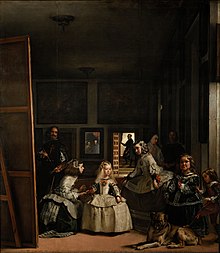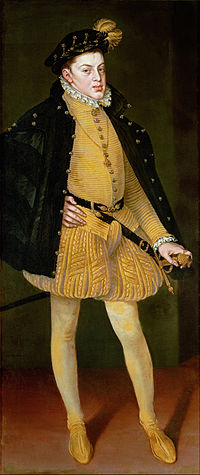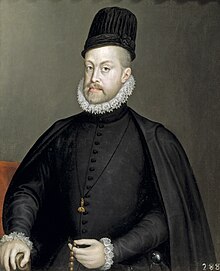Court painter

A court painter was an artist who painted for the members of a
Especially in the
In England the role of
Court sculptors were usually appointed when there was a large building programme that called for sculpture, or in periods, such as the decades around 1500 and the
Court portraits

Medieval and Renaissance monarchs usually met each other very rarely, if at all, despite the dense web of kinship that tied them together. Princesses married abroad often never saw their close family again, and royal children were generally raised away from court, and might not see their parents for considerable intervals. As well as being icons of grandeur, portraits might be all that family members saw of each other's for many years, and were often keenly awaited and carefully examined. In particular, portraits of royal children, circulated within the family, might be anxiously scrutinized, and used to diagnose health issues.[4]
Portraits of both parties to a marriage being negotiated were often exchanged, and for the men seem often to have been important in choosing a wife; it was preferred to send one's own painter to the lady, though the men were more often painted by an artist from the home side. One such portrait of Carlos, Prince of Asturias (1545–1568) was sent to Vienna, where a marriage was being considered, with a covering letter by the Austrian ambassador in Madrid noting aspects of his appearance that the painter had glossed over. The marriage never took place. Such portraits seem in fact to have been one of the earliest uses of court portraits, with examples from the 15th century, such as Henry VI of England sending "Hans the painter" to paint the daughters of John IV, Count of Armagnac as early as 1442.[5]
From the mid-16th century, as the exchange of royal portraits grew, the works of painters at the largest courts were seen across Europe, giving them great opportunities to advertise their style. The stylistic continuity in the Spanish court was especially marked, beginning with Titian, who painted Charles V and Philip II, but could not be induced to move to Spain. Antonis Mor, from the Netherlands, worked for the Habsburgs for several years and developed a style that at its best combined much of the grandeur and psychological penetration of Titian's portraits with a more severe and formal presentation, admired in Spain, and a Netherlandish attention to detail and finish.
He could not be kept long in Spain, but trained Alonso Sánchez Coello, who was Philip's court painter for 28 years, until his death in 1588. He in turn trained Juan Pantoja de la Cruz, his successor until he died in 1608. His pupil, the undistinguished Rodrigo de Villandrando then filled the role until his death in 1622, when the 23-year-old Diego Velázquez was summoned to Madrid, and soon hired for the court, remaining with it until his death in 1660. His portraits in many respects draw on his predecessors.
By the 17th century official portraits had an agreed model, occasionally renewed, which was increasingly copied in large numbers, often entirely by the court artist's workshop. Diplomatic exchanges of portraits of a new monarch became a standard courtesy, and the domestic nobility might be given them, or could buy them from the artist. By the 20th century the court painter was a largely obsolete position, even where royal courts remained. A variety of fashionable portraitists were given sittings by royalty, whether for their own commissions or those of others.
Asia and the Islamic world
In
In China court painters tended to work in an entirely different style and paint different subject-matter to the more respected literati painters, who mostly painted landscapes in monochrome ink wash painting, though there was overlap in both directions. The court style was usually what is known as gongbi ("meticulous"), brightly coloured, fairly realistic, and using precise brush-strokes. Typical subjects included a relatively small number of portraits of the imperial family, the viewing of which was largely restricted to the family itself, animals, birds and flowers, and paintings of imperial ceremonies and progresses. But landscapes were painted, some with views of rural imperial houses at the centre.
Designers for other media

At many periods rulers owned or controlled royal workshops or factories making high-quality
Women court artists
A number of women painters were successful in obtaining court commissions, though few gained the top positions. Some, like Sofonisba Anguissola, one of the most successful, were specifically in the service of the queen rather than the king, and appointed lady-in-waiting. Elisabeth of Valois, the third queen of Philip II of Spain, was a keen amateur painter, and it was considered easier in terms of court protocol to have a female tutor for her. Anguissola, from an Italian family of the minor aristocracy, was recruited to come to Madrid for this, starting immediately after the fourteen-year-old queen's wedding.[7] As well as the relaxed portrait style she had previously developed, she learnt the formal Spanish court style, and was used for portraits of male royalty. There is now some confusion between her work and that of the main court painter, Alonso Sánchez Coello, one of whose daughters also became a painter and assistant to her father.
The leading woman among the
The flower painter Rachel Ruysch (1664–1750) obtained a court position with Johann Wilhelm, Elector Palatine in 1708, but on terms that allowed her to remain in Amsterdam, only travelling to Düsseldorf periodically to deliver paintings. Angelica Kauffman in 1782 turned down an offer from the court of Naples in order to preserve her freedom.[9]
Incomplete list of court painters (A-Z)
Notes
References
- ISBN 0300046758
- "Dictionary": Dictionary of Women Artists: Introductory surveys; Artists, A-I, edited by Delia Gaze, Maja Mihajlovic, Leanda Shrimpton, "Court Artists", Google books
- Michael Levey, Painting at Court, Weidenfeld & Nicolson, London, 1971
- ISBN 0500232326
Further reading
- Campbell, John and Welch, Evelyn S., Artists at Court: Image-making and Identity, 1300-1550, 2004, ISBN 0914660233, 9780914660231
- ISBN 0521363756, 9780521363754

